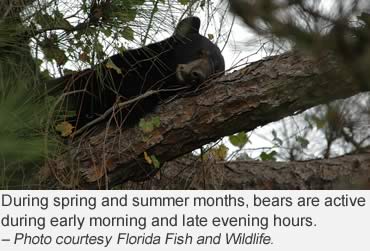Photo: Hungry bears eat whatever they can find, and in spring that’s often the seed in your birdfeeder. – Photo courtesy Michigan Department of Natural Resources.
It’s spring and the bear warnings have started.
If you live in areas frequently populated by black bears, you’ve heard good advice: Take down your birdfeeders. Clean your outdoor grills. Keep your camping area clean. Never leave pet food outside. Secure your trash cans. Use electric fencing around beehives, gardens and chicken coops. Be Bear Aware.
In other words, DO NOT FEED THE BEARS.
Even though bears can obtain all the nourishment they need from the forest, they are intelligent and opportunistic and will find and consume whatever food they can access most easily.
A hungry bear will pass through a developed area to reach habitat containing their seasonal food sources. But, if a bear finds readily-accessible food along the way because a human did not take necessary precautions, it will stop and dine.
 Not every bear that passes through a developed area is a problem bear, but easy-to-find human food sources can quickly turn it into one.
Not every bear that passes through a developed area is a problem bear, but easy-to-find human food sources can quickly turn it into one.
Thinking a wild black bear is as cuddly as a stuffed teddy bear is dangerous, but there’s a history to some of this faulty belief.
Many seniors remember when visitors could be seen offering treats to bears when touring the Great Smoky Mountain National Park. During the 1950s, feeding bears grew into something of a tourist attraction. This developed into a predictable problem, one resulting in bears injuring park guests.
During the same time, in the Capitan Mountains of New Mexico, a fire fighting crew rescued a small black bear cub during a raging wildfire. The crew survived the firestorm by lying facedown on a rockslide for more than an hour, but the bear cub they found nearby clinging to a burning tree had its paws and hind legs badly burned.
The crew rescued that small cub, and its story captured America’s attention. That bear cub grew into the friendly forest fire prevention icon that lives on as Smokey the Bear. Smokey continues to remind generations of school children to “Remember only YOU can prevent forest fires.”
 The real Smokey the Bear lived in the National Zoo in Washington, D.C., until its death in 1976. Now, visitors to the Great Smoky Mountains National Park see signs warning them that bears are dangerous and unpredictable wild animals. Park warnings advise checking "Bear Closures" and "Bear Warning" notices before planning a hike.
The real Smokey the Bear lived in the National Zoo in Washington, D.C., until its death in 1976. Now, visitors to the Great Smoky Mountains National Park see signs warning them that bears are dangerous and unpredictable wild animals. Park warnings advise checking "Bear Closures" and "Bear Warning" notices before planning a hike.
It’s good advice.
“As black bears become active in the spring, they are on a mission to find food,” said Laura Conlee, a resource scientist and black-bear researcher with the Missouri Department of Conservation.
"When bears lose their fear of people, they may approach people in search of food or may defend the food sources or territory they associate with people, which can make them dangerous," she said. "When this happens, the bear has to be destroyed. A fed bear is a dead bear."
And, a fed bear that becomes a problem in one place cannot be relocated.
“Once a bear learns that people can provide food, they will seek out other places such as camp sites, residential areas, and farms in search of food,” she explained. “Bears also have an excellent memory and will often return year after year to places where they were provided food.”
Keeping bears and humans separated is a common problem in states with growing bear populations.
"Everyone picks up the phone to call us looking for advice at a different point,” says Katie Keen, Michigan Department of Natural Resources wildlife communication coordinator. “For some, seeing a black bear is enough. For others, it may be regular or daytime visits that make them uneasy.
“Bears that receive a food reward when around homes, yards and neighborhoods typically lose their natural fear of humans and can become a potential threat to people and their pets,” she added.
But, one of the easiest things people can do to avoid problems with bears is to remove bird feeders during the spring and summer months. Bears are most active during early morning and late evening hours.
With an estimated 2,000-plus adult bear inhabiting Michigan’s northern Lower Peninsula, and almost 10,000 in the Upper Peninsula, there are plenty of bears searching for natural food that is plentiful in forests, fields and wetlands.
State conservation efforts have increased bear populations across the country.
In the 1970s, the estimated number of adult Florida black bears had fallen to only 300. But, with conservation efforts, that number has grown to more than 4,000 adult Florida black bears.
As bear numbers increase, ways of living with bears as neighbors have changed. Other subspecies of black bears also live throughout North America. Overall numbers have rebounded in recent years to an estimated 800,000 bears in 37 states and Canada.
Find the story of Smokey the Bear here.
You can read more about bears in the Great Smokey Mountains National Park here.
– Resources: Missouri Department of Conservation, Michigan Department of Natural Resources, Florida Fish and Wildlife Conservation Commission.